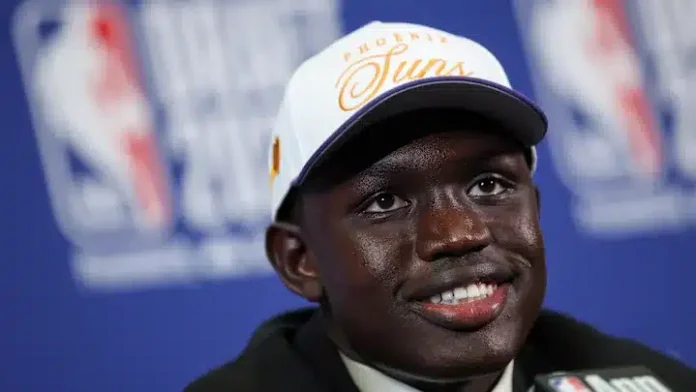With the 2025 NBA Draft behind us, it’s officially time to speculate about what these teams may look like in the 2026 season and beyond. Let’s discuss three teams we’re especially excited to track after their draft hauls from day one and two:
Phoenix’s young defensive core
After the last few seasons of Suns basketball, the following sentence still feels jarring to write — I’m fascinated by the defense Phoenix is building. The Suns placed 27th in defensive rating in 2025 (119.2), rolling out one of the league’s worst units. They finished a respectable 12th in 2024 (114.3), but that defense collapsed in the postseason.
Phoenix’s draft picks across the past two seasons made their intentions to fortify their defensive foundation abundantly clear. In 2024, the Suns drafted Ryan Dunn, widely considered the best defensive player in the class, and Oso Ighodaro, who improved Phoenix’s defense by 6.5 points per 100 possessions when he manned the paint.
The team spent the 2025 draft maintaining that direction, selecting two of the draft’s best defensive players — Khaman Maluach and Rasheer Fleming — with the 10th and 31st picks. While Ighodaro’s length and activity boosted a decrepit Suns interior, Maluach could develop into a true defensive anchor if he reaches his ceiling.
Fleming and Maluach are impressive defensive talents on their own, but the two complement each other and Phoenix’s existing pieces nicely. Maluach’s incredible help defense projects him as a dominant roamer big who will major in rim deterrence and big-space ground coverage. Fleming’s excellent perimeter defense and switchability will limit the leaks Maluach has to plug.
As a rookie, Dunn guarded opposing offenses’ primary perimeter scoring options as his team’s only strong on-ball defender, which nerfed his playmaking brilliance. Fleming and Dunn working in tandem to take away drives and force turnovers with Maluach behind them is an enticing defensive proposition.
The Suns are building a modern NBA defense with the pieces to create chaos and mix up coverages on a moment’s notice. As long as Dillon Brooks is around, that’s another excellent perimeter defender in the mix and a mentor to Phoenix’s young pieces.
The Hornets are finally prioritizing feel
Charlotte’s draft strategy in 2025 diverged from their recent historical preferences that dragged them to the NBA’s basement. Aside from LaMelo Ball and Brandon Miller, most of the Hornets’ recent draft picks leaned towards raw athleticism and microwave scoring — Tidjane Salaun, James Bouknight, Kai Jones, JT Thor, Miles Bridges and more.
In 2025, all four of the Hornets’ selections — Kon Knueppel, Liam McNeeley, Sion James and Ryan Kalkbrenner — should add on-court value early in their career. All four players thrive without the basketball, acting as connective tissue for their offensive focal points. McNeeley’s low-maintenance game, predicated on shooting and quick decision making, fits well next to on-ball stars.
Both of Charlotte’s second-round picks will bolster a Hornets’ defense that hasn’t finished inside the top 20 since 2018. James’s excellent on-ball stopping and Kalkbrenner’s rim protection should help them both find early work in the NBA and Kalkbrenner could start from center from day one in a barren frontcourt.
Describing Knueppel as a pure connector undersells his ceiling, as his elite processing on the move and all-around shooting grant him more upside than he often gets credit for. But he has a strong case as the best off-ball offensive player in the class who will excel as a secondary playmaker, off-ball shooter and closeout attacker.
Injuries have derailed the Hornets for much of the last few seasons, but they’ve accrued quite a bit of promising talent, finally prioritizing high-feel players requisite for success in the modern NBA. Hopefully, their draft additions can help lift Charlotte’s offense out of the bottom three for the first time since 2022.
The Brooklyn Nets’ confounding vision
I can’t remember a draft as universally lambasted as Brooklyn’s first-round haul, drafting a historic five players in one top-30. The Nets selected four of their five draft picks — Egor Demin, Nolan Traore, Ben Saraf and Drake Powell — above consensus rankings. Danny Wolf was their only consensus value (and I’m much lower on him than the mainstream opinion).
Drafting players above consensus isn’t inherently bad, but the Nets took five players who may struggle to fit and develop together. Brooklyn clearly prioritized passing and ball-handling with their selections, as all of their selections aside from Powell have handling and playmaking as their main strengths.
It’s an understandable strategy to some extent, given the importance of feel and passing to high-level winning basketball. Passing is an additive skill, critical for functioning next to on-ball stars. The Nets may have indexed on the wrong kinds of passers, though, as almost none of their picks are comfortable playing without the ball.
None of their selections, aside from Powell, shot above 34% from downtown (and Powell’s volume casts some doubt on his long-term shooting projection). Demin, Traore, Saraf and Wolf all have notable rim-finishing concerns. Only Traore and Powell sport positive defensive projections.
Developing a positive environment for growth is critical for prospect improvement. The Nets have to hope one of their handling players progresses significantly off the ball, which is an understandable bet, but off-ball acumen can be challenging to improve. The presence of Cam Thomas, who needs the ball in his hands on offense, only further muddles Brooklyn’s development plans.
In a vacuum, the Nets added promising talents to their core. In practice, it’s hard to imagine how the five of them harmonize together without cannibalizing each other’s development and optimal roles.



















